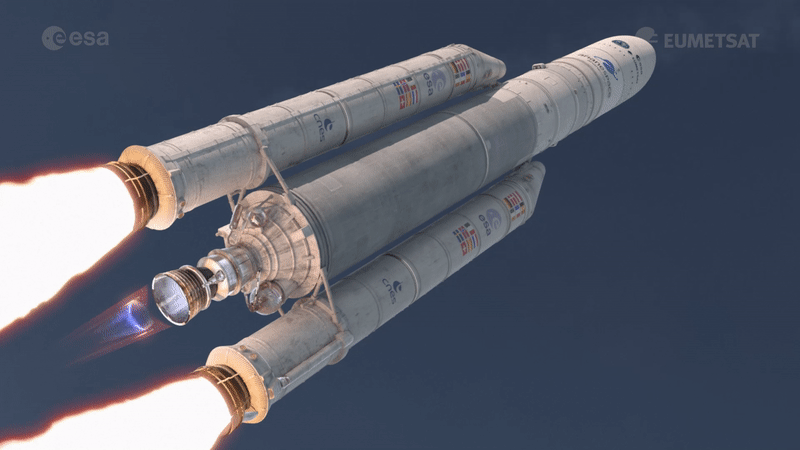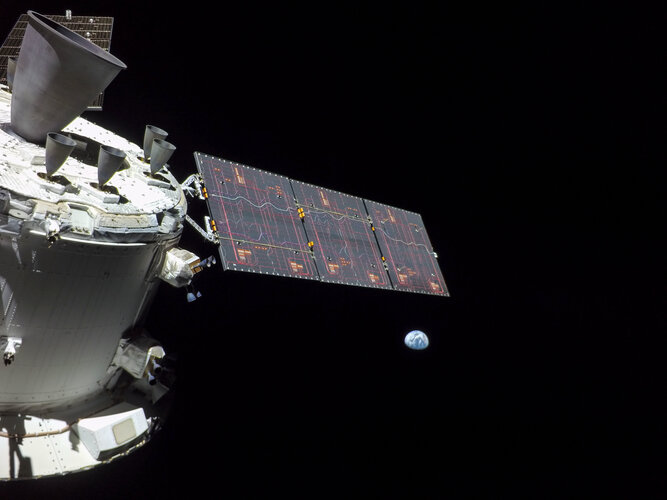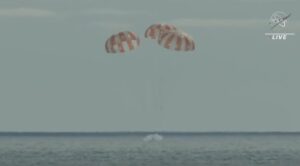China's new space station opens for business in an increasingly competitive era of space activity
Monday, 12 December 2022 07:17 The International Space Station is no longer the only place where humans can live in orbit.
On Nov. 29, 2022, the Shenzhou 15 mission launched from China's Gobi Desert carrying three taikonauts - the Chinese word for astronauts. Six hours later, they reached their destination, China's recently completed space station, called Tiangong, which means "heavenly palace" in Mandarin. The three ta
The International Space Station is no longer the only place where humans can live in orbit.
On Nov. 29, 2022, the Shenzhou 15 mission launched from China's Gobi Desert carrying three taikonauts - the Chinese word for astronauts. Six hours later, they reached their destination, China's recently completed space station, called Tiangong, which means "heavenly palace" in Mandarin. The three ta Watch live launch of Meteosat Third Generation Imager-1
Monday, 12 December 2022 06:50
On 13 December, the first of a new generation of satellites designed to revolutionise weather forecasting in Europe will take to the skies. ESA and the European Organisation for the Exploitation of Meteorological Satellites (Eumetsat) invite you to follow the live coverage for the launch of the first Meteosat Third Generation satellite starting from 19:40 CET on ESA Web TV.
Japanese startup launches historic Moon mission
Monday, 12 December 2022 00:24 A Japanese startup's spacecraft was launched to the Moon on Sunday in the country's first-ever lunar mission and the first of its kind by a private company.
The launch was carried out by Elon Musk's SpaceX at Cape Canaveral in the US state of Florida after two postponements for additional pre-flight checks.
The spacecraft, produced by Tokyo-based startup ispace and carrying a UAE-built r
A Japanese startup's spacecraft was launched to the Moon on Sunday in the country's first-ever lunar mission and the first of its kind by a private company.
The launch was carried out by Elon Musk's SpaceX at Cape Canaveral in the US state of Florida after two postponements for additional pre-flight checks.
The spacecraft, produced by Tokyo-based startup ispace and carrying a UAE-built r Orion splashes down after record-setting voyage around the Moon
Sunday, 11 December 2022 18:12 NASA's Orion space capsule splashed down safely in the Pacific on Sunday, completing the Artemis 1 mission -- a more than 25-day journey around the Moon with an eye to returning humans there in just a few years. After racing through the Earth's atmosphere at a speed of 40,000 kilometers per hour (25,000 mph), the uncrewed capsule floated down to the sea with the help of three large red and white parachutes, as seen on NASA TV.
NASA's Orion space capsule splashed down safely in the Pacific on Sunday, completing the Artemis 1 mission -- a more than 25-day journey around the Moon with an eye to returning humans there in just a few years. After racing through the Earth's atmosphere at a speed of 40,000 kilometers per hour (25,000 mph), the uncrewed capsule floated down to the sea with the help of three large red and white parachutes, as seen on NASA TV. NASA's Orion capsule blazes home from test flight to moon
Sunday, 11 December 2022 17:25
NASA's Orion capsule made a blisteringly fast return from the moon Sunday, parachuting into the Pacific off Mexico to conclude a test flight that should clear the way for astronauts on the next lunar flyby.
NASA Orion capsule safely blazes back from moon, aces test
Sunday, 11 December 2022 17:25
NASA's Orion capsule made a blisteringly fast return from the moon Sunday, parachuting into the Pacific off Mexico to conclude a test flight that should clear the way for astronauts on the next lunar flyby.
First Artemis lunar mission ends, so long European Service Module-1
Sunday, 11 December 2022 16:51
Orion splashes down to end Artemis 1
Sunday, 11 December 2022 16:50
Fifty years to the day after the last Apollo moon mission touched down on the lunar surface, NASA’s plans to return to the moon took a major step forward with the successful splashdown of the Orion spacecraft to end the Artemis 1 mission.
Space Command promotes role in Artemis 1
Sunday, 11 December 2022 15:39
As Artemis 1 nears its conclusion, U.S. Space Command is using the mission to highlight its role in supporting NASA, even as the space agency considers alternatives to some of those services.
The post Space Command promotes role in Artemis 1 appeared first on SpaceNews.
NASA Moon capsule Orion due to splash down after record-setting voyage
Sunday, 11 December 2022 11:52 After making a close pass at the Moon and venturing further into space than any previous habitable spacecraft, NASA's Orion capsule is due to splash down Sunday in the final test of a high-stakes mission called Artemis.
As it hurtles into Earth's atmosphere at a speed of 25,000 miles (40,000 kilometers) per hour, the gumdrop-shaped traveler will have to withstand a temperature of 2,800 degre
After making a close pass at the Moon and venturing further into space than any previous habitable spacecraft, NASA's Orion capsule is due to splash down Sunday in the final test of a high-stakes mission called Artemis.
As it hurtles into Earth's atmosphere at a speed of 25,000 miles (40,000 kilometers) per hour, the gumdrop-shaped traveler will have to withstand a temperature of 2,800 degre Terran Orbital creates new Optical Solutions Group
Sunday, 11 December 2022 11:52 Terran Orbital Corporation (NYSE: LLAP), a global leader in satellite-based solutions primarily serving the aerospace and defense industries, has announced the formation of a new Optical Solutions Group (OSG) focused on electro-optical (EO) satellite imaging products. The new group will concentrate on development and innovation of new EO products while offering a wide variety of custom-made and
Terran Orbital Corporation (NYSE: LLAP), a global leader in satellite-based solutions primarily serving the aerospace and defense industries, has announced the formation of a new Optical Solutions Group (OSG) focused on electro-optical (EO) satellite imaging products. The new group will concentrate on development and innovation of new EO products while offering a wide variety of custom-made and PSLV-XL rocket motor made by industry passes test: ISRO
Sunday, 11 December 2022 11:52 The Indian Space Research Organisation (ISRO) said the performance of the booster motor made by Economic Explosives Limited for its PSLV-XL rocket was satisfactory.
The Indian space agency tested the booster motor called PSOM-XL at its rocket port in Sriharikota on Wednesday.
According to the ISRO, with this test, the private industry's capability to produce the stage for PSLV has be
The Indian Space Research Organisation (ISRO) said the performance of the booster motor made by Economic Explosives Limited for its PSLV-XL rocket was satisfactory.
The Indian space agency tested the booster motor called PSOM-XL at its rocket port in Sriharikota on Wednesday.
According to the ISRO, with this test, the private industry's capability to produce the stage for PSLV has be AFRL, CNM Ingenuity shift innovation to next level at Hyperdrive Space Summit
Sunday, 11 December 2022 11:52 The Air Force Research Laboratory, or AFRL, partnered with CNM Ingenuity, or CNMI, the economic development arm of Central New Mexico Community College, to hold the 2022 Hyperdrive Space Summit in Albuquerque, New Mexico, Nov. 15-17, 2022. The Hyperdrive Space Summit is an evolution of the Hyperspace Challenge that AFRL's Technology Outreach Office began in 2018, in collaboration with CNMI, with
The Air Force Research Laboratory, or AFRL, partnered with CNM Ingenuity, or CNMI, the economic development arm of Central New Mexico Community College, to hold the 2022 Hyperdrive Space Summit in Albuquerque, New Mexico, Nov. 15-17, 2022. The Hyperdrive Space Summit is an evolution of the Hyperspace Challenge that AFRL's Technology Outreach Office began in 2018, in collaboration with CNMI, with US grants OQ more patents for world's first 5G IoT satellite LEO constellation
Sunday, 11 December 2022 11:52 The US Patent and Trademark Office has granted OQ Technology, the pioneer of 5G IoT satellite services, patents for its "frequency synchronisation" and "timing synchronisation" technology. The two synchronisation technologies are already used for communicating with the satellites in the company's growing 5G IoT (Internet of Things) constellation connecting IoT devices globally.
Following t
The US Patent and Trademark Office has granted OQ Technology, the pioneer of 5G IoT satellite services, patents for its "frequency synchronisation" and "timing synchronisation" technology. The two synchronisation technologies are already used for communicating with the satellites in the company's growing 5G IoT (Internet of Things) constellation connecting IoT devices globally.
Following t Microchip showcases RISC-V-based FPGA and space-compute solutions at RISC-V Summit
Sunday, 11 December 2022 11:52 Mid-range FPGAs and System-on-Chip (SoC) FPGAs have played a major role in moving computer workloads to the network edge. Microchip Technology (Nasdaq: MCHP) has helped fuel this transition with its award-winning FPGAs, while also delivering the first RISC-V-based FPGAs that provide twice the power efficiency of competing mid-range FPGAs, and feature a best-in-class design, operating system and
Mid-range FPGAs and System-on-Chip (SoC) FPGAs have played a major role in moving computer workloads to the network edge. Microchip Technology (Nasdaq: MCHP) has helped fuel this transition with its award-winning FPGAs, while also delivering the first RISC-V-based FPGAs that provide twice the power efficiency of competing mid-range FPGAs, and feature a best-in-class design, operating system and 
